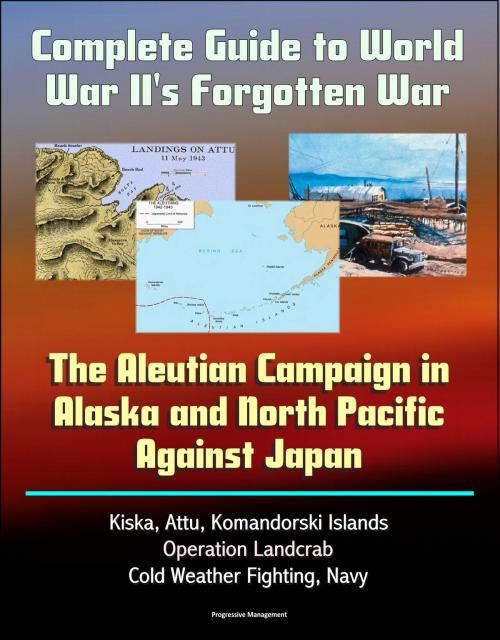Complete Guide to World War II's Forgotten War: The Aleutian Campaign in Alaska and North Pacific Against Japan - Kiska, Attu, Komandorski Islands, Operation Landcrab, Cold Weather Fighting, Navy
Nonfiction, History, Military, World War II| Author: | Progressive Management | ISBN: | 9781310027963 |
| Publisher: | Progressive Management | Publication: | March 4, 2015 |
| Imprint: | Smashwords Edition | Language: | English |
| Author: | Progressive Management |
| ISBN: | 9781310027963 |
| Publisher: | Progressive Management |
| Publication: | March 4, 2015 |
| Imprint: | Smashwords Edition |
| Language: | English |
This comprehensive, professionally-formatted flowing text ebook provides a complete guide to the Aleutian campaign in World War II, incorporating seventeen official documents and histories with vivid details and insightful analysis.
Contents: The Aleutians - Lessons From A Forgotten Campaign * World War II in the Aleutians: The Fundamentals of Joint Campaigns * The Aleutian Campaign: Lessons in Operational Design * The "Moose Muss" of the Aleutian Campaign: An Operational Analysis Using the Principles of War * The Aleutian Islands Campaign - An Operational Art Perspective * Fighting The Cold: The Need for Standing Cold Weather Combat Capabilities * The Aleutian Campaign In World War II: A Strategic Perspective * Mountain and Cold Weather Warfighting: Critical Capability for the 21st Century * Imperial Japanese Navy Campaign Planning and Design of the Aleutian-Midway Campaign * Aleutian Campaign, World War II: Historical Study and Current Perspective * Weather as the Decisive Factor of the Aleutian Campaign, June 1942 - August 1943 * Victory in the Aleutians: An Analysis of Jointlessness * Effective Operational Deception: Learning the Lessons of Midway and Desert Storm * Memories of the Aleutians Campaign, WWII * Aleutian Islands - The U.S. Army Campaigns of World War II * The Aleutians Campaign - June 1942 to August 1943 * World War II in Alaska
In the summer of 1943, the United States and the Imperial Japanese Empire struggled violently over one of the most desolate pieces of ground in the Northern Pacific. The Aleutian chain of islands, part of the territory of Alaska, became the battleground for a dramatic conflict in the Second World War. The campaign for the Aleutians represented on both sides key strategic objectives and Interests, and eventually cost considerable lives. Alaska's role as battlefield, lend-lease transfer station, and North Pacific stronghold was often overlooked by historians in the post-war decades, but in recent years awareness has been growing of Alaska's wartime past.
Six months after the attack on Pearl Harbor, the Japanese bombed the U.S. Dutch Harbor Naval Operating Base and U.S. Army Fort Mears, near Unalaska Island and occupied the Aleutian islands of Attu and Kiska. For many decades following the War, the prevailing understanding about the Japanese Aleutian operation was that it served as a mere diversionary measure from their Midway operation. Recent research, however, concludes that the Japanese had a broader and longer term strategy to establish and expand an eastern defensive perimeter. In response, U.S. military strategists knew that they could not risk leaving the Aleutians open as stepping stones for Japanese attacks on the United States mainland. In addition, the occupation was a significant propaganda victory for the Japanese—the affront could not go unanswered.
Aleutian Campaign - Because planes departing from Kodiak and Dutch Harbor did not have the nearly 1,400 mile range to engage the Japanese at Attu and Kiska, U.S. forces built bases on other Aleutian islands as refueling and maintenance stops, allowing them to strike further west. Pilots and ground troops soon realized they were facing a second enemy, Mother Nature. Weather along the Aleutian chain is some of the worst in the world, with dense fogs, violent seas, and fierce wind storms called williwaws. Aircraft lacking accurate navigational devices or consistent radio contact crashed into mountains, each other, the sea—simply finding the enemy was a life-and-death struggle. For soldiers in the Aleutians, contact with the enemy was infrequent and fleeting, but the weather was a perpetual adversary.
This comprehensive, professionally-formatted flowing text ebook provides a complete guide to the Aleutian campaign in World War II, incorporating seventeen official documents and histories with vivid details and insightful analysis.
Contents: The Aleutians - Lessons From A Forgotten Campaign * World War II in the Aleutians: The Fundamentals of Joint Campaigns * The Aleutian Campaign: Lessons in Operational Design * The "Moose Muss" of the Aleutian Campaign: An Operational Analysis Using the Principles of War * The Aleutian Islands Campaign - An Operational Art Perspective * Fighting The Cold: The Need for Standing Cold Weather Combat Capabilities * The Aleutian Campaign In World War II: A Strategic Perspective * Mountain and Cold Weather Warfighting: Critical Capability for the 21st Century * Imperial Japanese Navy Campaign Planning and Design of the Aleutian-Midway Campaign * Aleutian Campaign, World War II: Historical Study and Current Perspective * Weather as the Decisive Factor of the Aleutian Campaign, June 1942 - August 1943 * Victory in the Aleutians: An Analysis of Jointlessness * Effective Operational Deception: Learning the Lessons of Midway and Desert Storm * Memories of the Aleutians Campaign, WWII * Aleutian Islands - The U.S. Army Campaigns of World War II * The Aleutians Campaign - June 1942 to August 1943 * World War II in Alaska
In the summer of 1943, the United States and the Imperial Japanese Empire struggled violently over one of the most desolate pieces of ground in the Northern Pacific. The Aleutian chain of islands, part of the territory of Alaska, became the battleground for a dramatic conflict in the Second World War. The campaign for the Aleutians represented on both sides key strategic objectives and Interests, and eventually cost considerable lives. Alaska's role as battlefield, lend-lease transfer station, and North Pacific stronghold was often overlooked by historians in the post-war decades, but in recent years awareness has been growing of Alaska's wartime past.
Six months after the attack on Pearl Harbor, the Japanese bombed the U.S. Dutch Harbor Naval Operating Base and U.S. Army Fort Mears, near Unalaska Island and occupied the Aleutian islands of Attu and Kiska. For many decades following the War, the prevailing understanding about the Japanese Aleutian operation was that it served as a mere diversionary measure from their Midway operation. Recent research, however, concludes that the Japanese had a broader and longer term strategy to establish and expand an eastern defensive perimeter. In response, U.S. military strategists knew that they could not risk leaving the Aleutians open as stepping stones for Japanese attacks on the United States mainland. In addition, the occupation was a significant propaganda victory for the Japanese—the affront could not go unanswered.
Aleutian Campaign - Because planes departing from Kodiak and Dutch Harbor did not have the nearly 1,400 mile range to engage the Japanese at Attu and Kiska, U.S. forces built bases on other Aleutian islands as refueling and maintenance stops, allowing them to strike further west. Pilots and ground troops soon realized they were facing a second enemy, Mother Nature. Weather along the Aleutian chain is some of the worst in the world, with dense fogs, violent seas, and fierce wind storms called williwaws. Aircraft lacking accurate navigational devices or consistent radio contact crashed into mountains, each other, the sea—simply finding the enemy was a life-and-death struggle. For soldiers in the Aleutians, contact with the enemy was infrequent and fleeting, but the weather was a perpetual adversary.















